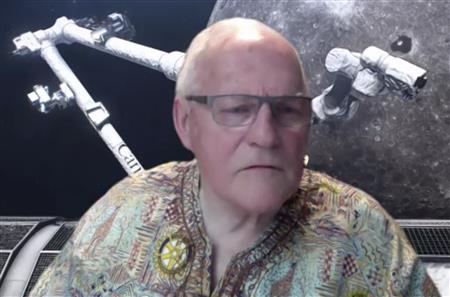
Bob Morrow shared an update on the work of the Canadian Space Agency. He began with an overview of the CSA and their work. First he shared some inspiring images of the International Space Station, the Sun, the Moon, Mars, Saturn, and Earth. All the photos were amazing. That we are able to “see” close up the Moon which is 384,000 km away from Earth, or Mars which ranges from 54,000,000 to 400,000,000 km depending on its orbit or the Sun which is 146,000,000,km away is mind blowing.
The Canadian Space Agency does not build rocket ships—that enormously expensive business is done by others, but it does delve deeply into issues that affect the human body in space, the robotics required to do experimentation and data collection while in space, and the effects closed environment systems have on humans, plants, seeds and other life forms. Every project undertaken by the CSA must have relevance to life on the surface of Earth as well as life in space. Perhaps the best known Canadian Space Agency contribution to space exploration is the robotic Canada Arm. There are now three iterations of this incredible machine. Canada Arm2 remains permanently on the International Space Station. Bob showed us a photo of Canadian astronaut Dave Williams tethered to the arm—a feat of courage and engineering!
Of course space exploration in the most recent days has become the billionaire’s amusement. Bob had pictures of SpaceX Dragon coming in to dock at the I.S.S.. Certainly, both Elon Musk and Jim Bezos bring a celebrity cache to all things space. But whether they will trump the space programmes of nation states remains to be seen. The desire to explore space is probably an innate human one—from star gazing in the BCE, to the travels to outer limits today. Many of us have grown up watching television shows like Star Trek, Lost in Space, and ST The Next Generation and watching as many launches in the 60’s and 70’s as possible from Mercury to Apollo, to the Shuttles. So much progress has been made in 60 years. The age old saying, “Life imitates art” may not yet be true but we are much closer to space as the final frontier than we have ever been.
All of which brings us to the newest possibility that there may be life on Mars. Bob showed us photos of rounded stones on the planet’s surface. Such rounding could only have occurred if there had been water. He had photos from the “Perseverance” and “Jenny” its land rover. As scientists work to discover whether there is water on the red planet that would be usable for humans, we can be awed by the knowledge and skills being developed in this journey.
Bob may have always been fascinated by space travel, but it was his work on the Tomatosphere Project that gave him access to the C.S.A. and a number of Canadian astronauts and to experiences that are truly special.
As mentioned earlier, one of the C.S.A.’s mandates is to study the effects of closed environment systems on seeds. Tomato seeds were chosen as one of the demonstration seeds because tomatoes are nutritious, a source of lycopene and most of all, excellent at converting carbon dioxide into oxygen. Thousands of tomato seeds were transported to space and returned to Earth for study. The object was to determine whether this travel, hundreds of millions of kilometers, impacted the ability of the seeds to germinate. And the answer was “No”. The next seed group being sent to space will be barley. So, perhaps there will one day be a pub serving pizza on Mars!
Bob then spoke about evolving issues in space exploration. First, there is already a fair bit of debris in space swirling in a vacuum at speeds of 17,000 km/hr.; one does not want to be hit with objects going at that speed. “Space Tourism” will only increase this problem, as will the thousands of satellites being launched to both surveille and support our contemporary world. Defunct satellites litter the cosmos. Secondly, there is the pressing issue of “who owns space” – a political, scientific, existential, and philosophical question. These are just two of the current issues surrounding space exploration.
Finally, Bob shared some of the learnings astronauts like Dave Williams, Robert Thursk, and Chris Hadfield had after their incredible experiences. They reported their greatest fear in space was fire. The everyday thing that was very important was “never put anything down” – it won’t stay put. Everything must be attached or else it floats away. And, most importantly, in order to accomplish the mission, everyone must work together as a team.
To date Canada has sent 12 astronauts to space; we have two more ready for assignments, Jennifer Sidey Gibbons, and Joshua Kutryk. Keep these names in mind for the future.